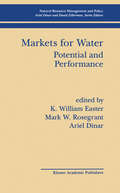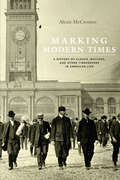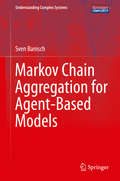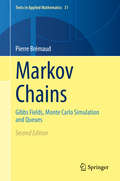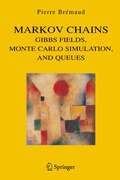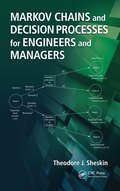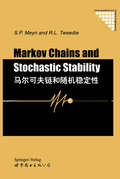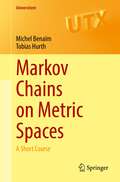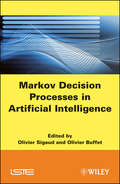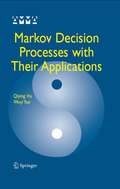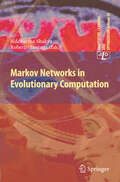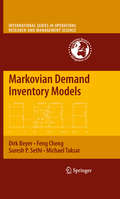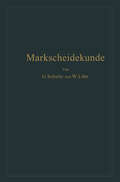- Table View
- List View
Marketingkonzeptionen für Ingenieure (essentials)
by Ekbert HeringMarketing ist nach modernem Verständnis die Führung eines Unternehmens vom Markt her. Erfolgreich wird ein Unternehmen nur sein, wenn es seine Produkte und Dienstleistungen so bereitstellt, dass sie den Bedürfnissen des Marktes entsprechen und somit aktuelle Kundenwünsche befriedigen. Für eine erfolgreiche Marketingkonzeption ist folgendes entscheidend: Trends zu erkennen, Kundengruppen zu selektieren und deren Bedürfnisse relativ zum Wettbewerber besser zu befriedigen sowie dies den betreffenden Kunden zu kommunizieren. Die daraus abgeleitete Systematik wird durch den Marketingmix beschrieben, der durch die neun P: Produkt-Mix (product), Preis-Mix (price), Distributions-Mix (Place), Kommunikations-Mix (Promotion), Kontrahierungs-Mix (Precise contract), Mitarbeiter-Mix (People), Prozesse, Gebäude und Anlagen (Physical Facilities) sowie Kooperations-Mix (Partnership) gekennzeichnet ist. Marketing-Controlling ermöglicht es, die gesetzten Ziele zeitnah zu erfassen, die Zieleinhaltung festzustellen und entsprechende Korrekturen vorzunehmen.
Markets and Policy Measures in the Evolution of Electric Mobility (Lecture Notes in Mobility)
by Dirk Fornahl Michael HülsmannThis edited monograph collects theoretical, empirical and political contributions from different fields, focusing on the commercial launch of electric mobility, and intending to shed more light on the complexity of supply and demand. It is an ongoing discussion, both in the public as well as in academia, whether or not electric mobility is capable of gaining a considerable market share in the near future. The target audience primarily comprises researchers and practitioners in the field, but the book may also be beneficial for graduate students.
Markets for Water: Potential and Performance (Natural Resource Management and Policy #15)
by K. William Easter Mark W. Rosegrant Ariel DinarMarkets for Water: Potential and Performance dispels many of the myths surrounding water markets and gives readers a comprehensive picture of the way that markets have developed in different parts of the world. It is possible, for example, for a water market to fail, and for the transaction costs in water markets to be excessive. Too often water trading is banned because the water resources have been developed with public funds and the water agencies do not want to lose control over water. There is also a concern that poor farmers or households will be disadvantaged by water trading. These concerns about public resources and the poor are not very different from those that have been voiced in the past about land sales. The problem is that in many cases the poor already have limited access to resources, but this limit is not due to water trading. In fact, water trading is likely to expand the access to water for many small-scale farmers. Markets for Water: Potential and Performance provides an analytical framework for water market establishment. It develops the necessary conditions for water markets and illustrates how they can improve both water management and economic efficiency. Finally, the book gives readers an up-to-date picture of what we have learned about water markets in a wide range of countries, from the US to Chile and India.
Marking Modern Times: A History of Clocks, Watches, and Other Timekeepers in American Life
by Alexis McCrossenThe public spaces and buildings of the United States are home to many thousands of timepieces—bells, time balls, and clock faces—that tower over urban streets, peek out from lobbies, and gleam in store windows. And in the streets and squares beneath them, men, women, and children wear wristwatches of all kinds. Americans have decorated their homes with clocks and included them in their poetry, sermons, stories, and songs. And as political instruments, social tools, and cultural symbols, these personal and public timekeepers have enjoyed a broad currency in art, life, and culture. In Marking Modern Times, Alexis McCrossen relates how the American preoccupation with time led people from across social classes to acquire watches and clocks. While noting the difficulties in regulating and synchronizing so many timepieces, McCrossen expands our understanding of the development of modern time discipline, delving into the ways we have standardized time and describing how timekeepers have served as political, social, and cultural tools in a society that doesn’t merely value time but regards access to time as a natural-born right, a privilege of being an American.
Marking Modern Times: A History of Clocks, Watches, and Other Timekeepers in American Life
by Alexis McCrossenThe public spaces and buildings of the United States are home to many thousands of timepieces—bells, time balls, and clock faces—that tower over urban streets, peek out from lobbies, and gleam in store windows. And in the streets and squares beneath them, men, women, and children wear wristwatches of all kinds. Americans have decorated their homes with clocks and included them in their poetry, sermons, stories, and songs. And as political instruments, social tools, and cultural symbols, these personal and public timekeepers have enjoyed a broad currency in art, life, and culture. In Marking Modern Times, Alexis McCrossen relates how the American preoccupation with time led people from across social classes to acquire watches and clocks. While noting the difficulties in regulating and synchronizing so many timepieces, McCrossen expands our understanding of the development of modern time discipline, delving into the ways we have standardized time and describing how timekeepers have served as political, social, and cultural tools in a society that doesn’t merely value time but regards access to time as a natural-born right, a privilege of being an American.
Marking Modern Times: A History of Clocks, Watches, and Other Timekeepers in American Life
by Alexis McCrossenThe public spaces and buildings of the United States are home to many thousands of timepieces—bells, time balls, and clock faces—that tower over urban streets, peek out from lobbies, and gleam in store windows. And in the streets and squares beneath them, men, women, and children wear wristwatches of all kinds. Americans have decorated their homes with clocks and included them in their poetry, sermons, stories, and songs. And as political instruments, social tools, and cultural symbols, these personal and public timekeepers have enjoyed a broad currency in art, life, and culture. In Marking Modern Times, Alexis McCrossen relates how the American preoccupation with time led people from across social classes to acquire watches and clocks. While noting the difficulties in regulating and synchronizing so many timepieces, McCrossen expands our understanding of the development of modern time discipline, delving into the ways we have standardized time and describing how timekeepers have served as political, social, and cultural tools in a society that doesn’t merely value time but regards access to time as a natural-born right, a privilege of being an American.
Marking Modern Times: A History of Clocks, Watches, and Other Timekeepers in American Life
by Alexis McCrossenThe public spaces and buildings of the United States are home to many thousands of timepieces—bells, time balls, and clock faces—that tower over urban streets, peek out from lobbies, and gleam in store windows. And in the streets and squares beneath them, men, women, and children wear wristwatches of all kinds. Americans have decorated their homes with clocks and included them in their poetry, sermons, stories, and songs. And as political instruments, social tools, and cultural symbols, these personal and public timekeepers have enjoyed a broad currency in art, life, and culture. In Marking Modern Times, Alexis McCrossen relates how the American preoccupation with time led people from across social classes to acquire watches and clocks. While noting the difficulties in regulating and synchronizing so many timepieces, McCrossen expands our understanding of the development of modern time discipline, delving into the ways we have standardized time and describing how timekeepers have served as political, social, and cultural tools in a society that doesn’t merely value time but regards access to time as a natural-born right, a privilege of being an American.
Marking Modern Times: A History of Clocks, Watches, and Other Timekeepers in American Life
by Alexis McCrossenThe public spaces and buildings of the United States are home to many thousands of timepieces—bells, time balls, and clock faces—that tower over urban streets, peek out from lobbies, and gleam in store windows. And in the streets and squares beneath them, men, women, and children wear wristwatches of all kinds. Americans have decorated their homes with clocks and included them in their poetry, sermons, stories, and songs. And as political instruments, social tools, and cultural symbols, these personal and public timekeepers have enjoyed a broad currency in art, life, and culture. In Marking Modern Times, Alexis McCrossen relates how the American preoccupation with time led people from across social classes to acquire watches and clocks. While noting the difficulties in regulating and synchronizing so many timepieces, McCrossen expands our understanding of the development of modern time discipline, delving into the ways we have standardized time and describing how timekeepers have served as political, social, and cultural tools in a society that doesn’t merely value time but regards access to time as a natural-born right, a privilege of being an American.
Marking Modern Times: A History of Clocks, Watches, and Other Timekeepers in American Life
by Alexis McCrossenThe public spaces and buildings of the United States are home to many thousands of timepieces—bells, time balls, and clock faces—that tower over urban streets, peek out from lobbies, and gleam in store windows. And in the streets and squares beneath them, men, women, and children wear wristwatches of all kinds. Americans have decorated their homes with clocks and included them in their poetry, sermons, stories, and songs. And as political instruments, social tools, and cultural symbols, these personal and public timekeepers have enjoyed a broad currency in art, life, and culture. In Marking Modern Times, Alexis McCrossen relates how the American preoccupation with time led people from across social classes to acquire watches and clocks. While noting the difficulties in regulating and synchronizing so many timepieces, McCrossen expands our understanding of the development of modern time discipline, delving into the ways we have standardized time and describing how timekeepers have served as political, social, and cultural tools in a society that doesn’t merely value time but regards access to time as a natural-born right, a privilege of being an American.
Markov Chain Aggregation for Agent-Based Models (Understanding Complex Systems)
by Sven BanischThis self-contained text develops a Markov chain approach that makes the rigorous analysis of a class of microscopic models that specify the dynamics of complex systems at the individual level possible. It presents a general framework of aggregation in agent-based and related computational models, one which makes use of lumpability and information theory in order to link the micro and macro levels of observation. The starting point is a microscopic Markov chain description of the dynamical process in complete correspondence with the dynamical behavior of the agent-based model (ABM), which is obtained by considering the set of all possible agent configurations as the state space of a huge Markov chain. An explicit formal representation of a resulting “micro-chain” including microscopic transition rates is derived for a class of models by using the random mapping representation of a Markov process. The type of probability distribution used to implement the stochastic part of the model, which defines the updating rule and governs the dynamics at a Markovian level, plays a crucial part in the analysis of “voter-like” models used in population genetics, evolutionary game theory and social dynamics. The book demonstrates that the problem of aggregation in ABMs - and the lumpability conditions in particular - can be embedded into a more general framework that employs information theory in order to identify different levels and relevant scales in complex dynamical systems
Markov Chains: Gibbs Fields, Monte Carlo Simulation and Queues (Texts in Applied Mathematics #31)
by Pierre BrémaudPrimarily an introduction to the theory of stochastic processes at the undergraduate or beginning graduate level, the primary objective of this book is to initiate students in the art of stochastic modelling. However it is motivated by significant applications and progressively brings the student to the borders of contemporary research. Examples are from a wide range of domains, including operations research and electrical engineering. Researchers and students in these areas as well as in physics, biology and the social sciences will find this book of interest.
Markov Chains: Gibbs Fields, Monte Carlo Simulation, and Queues (Texts in Applied Mathematics #31)
by Pierre BremaudPrimarily an introduction to the theory of stochastic processes at the undergraduate or beginning graduate level, the primary objective of this book is to initiate students in the art of stochastic modelling. However it is motivated by significant applications and progressively brings the student to the borders of contemporary research. Examples are from a wide range of domains, including operations research and electrical engineering. Researchers and students in these areas as well as in physics, biology and the social sciences will find this book of interest.
Markov Chains and Decision Processes for Engineers and Managers
by Theodore J. SheskinRecognized as a powerful tool for dealing with uncertainty, Markov modeling can enhance your ability to analyze complex production and service systems. However, most books on Markov chains or decision processes are often either highly theoretical, with few examples, or highly prescriptive, with little justification for the steps of the algorithms u
Markov Chains and Stochastic Stability (Communications and Control Engineering)
by Sean P. Meyn Richard L. TweedieMarkov Chains and Stochastic Stability is part of the Communications and Control Engineering Series (CCES) edited by Professors B.W. Dickinson, E.D. Sontag, M. Thoma, A. Fettweis, J.L. Massey and J.W. Modestino. The area of Markov chain theory and application has matured over the past 20 years into something more accessible and complete. It is of increasing interest and importance. This publication deals with the action of Markov chains on general state spaces. It discusses the theories and the use to be gained, concentrating on the areas of engineering, operations research and control theory. Throughout, the theme of stochastic stability and the search for practical methods of verifying such stability, provide a new and powerful technique. This does not only affect applications but also the development of the theory itself. The impact of the theory on specific models is discussed in detail, in order to provide examples as well as to demonstrate the importance of these models. Markov Chains and Stochastic Stability can be used as a textbook on applied Markov chain theory, provided that one concentrates on the main aspects only. It is also of benefit to graduate students with a standard background in countable space stochastic models. Finally, the book can serve as a research resource and active tool for practitioners.
Markov Chains on Metric Spaces: A Short Course (Universitext)
by Michel Benaïm Tobias HurthThis book gives an introduction to discrete-time Markov chains which evolve on a separable metric space. The focus is on the ergodic properties of such chains, i.e., on their long-term statistical behaviour. Among the main topics are existence and uniqueness of invariant probability measures, irreducibility, recurrence, regularizing properties for Markov kernels, and convergence to equilibrium. These concepts are investigated with tools such as Lyapunov functions, petite and small sets, Doeblin and accessible points, coupling, as well as key notions from classical ergodic theory. The theory is illustrated through several recurring classes of examples, e.g., random contractions, randomly switched vector fields, and stochastic differential equations, the latter providing a bridge to continuous-time Markov processes. The book can serve as the core for a semester- or year-long graduate course in probability theory with an emphasis on Markov chains or random dynamics. Some of the material is also well suited for an ergodic theory course. Readers should have taken an introductory course on probability theory, based on measure theory. While there is a chapter devoted to chains on a countable state space, a certain familiarity with Markov chains on a finite state space is also recommended.
Markov Decision Processes in Artificial Intelligence
by Olivier Sigaud Olivier BuffetMarkov Decision Processes (MDPs) are a mathematical framework for modeling sequential decision problems under uncertainty as well as Reinforcement Learning problems. Written by experts in the field, this book provides a global view of current research using MDPs in Artificial Intelligence. It starts with an introductory presentation of the fundamental aspects of MDPs (planning in MDPs, Reinforcement Learning, Partially Observable MDPs, Markov games and the use of non-classical criteria). Then it presents more advanced research trends in the domain and gives some concrete examples using illustrative applications.
Markov Decision Processes in Artificial Intelligence
by Olivier Sigaud Olivier BuffetMarkov Decision Processes (MDPs) are a mathematical framework for modeling sequential decision problems under uncertainty as well as Reinforcement Learning problems. Written by experts in the field, this book provides a global view of current research using MDPs in Artificial Intelligence. It starts with an introductory presentation of the fundamental aspects of MDPs (planning in MDPs, Reinforcement Learning, Partially Observable MDPs, Markov games and the use of non-classical criteria). Then it presents more advanced research trends in the domain and gives some concrete examples using illustrative applications.
Markov Decision Processes with Their Applications (Advances in Mechanics and Mathematics #14)
by Qiying Hu Wuyi YuePut together by two top researchers in the Far East, this text examines Markov Decision Processes - also called stochastic dynamic programming - and their applications in the optimal control of discrete event systems, optimal replacement, and optimal allocations in sequential online auctions. This dynamic new book offers fresh applications of MDPs in areas such as the control of discrete event systems and the optimal allocations in sequential online auctions.
Markov Networks in Evolutionary Computation (Adaptation, Learning, and Optimization #14)
by Siddhartha Shakya Roberto SantanaMarkov networks and other probabilistic graphical modes have recently received an upsurge in attention from Evolutionary computation community, particularly in the area of Estimation of distribution algorithms (EDAs). EDAs have arisen as one of the most successful experiences in the application of machine learning methods in optimization, mainly due to their efficiency to solve complex real-world optimization problems and their suitability for theoretical analysis.This book focuses on the different steps involved in the conception, implementation and application of EDAs that use Markov networks, and undirected models in general. It can serve as a general introduction to EDAs but covers also an important current void in the study of these algorithms by explaining the specificities and benefits of modeling optimization problems by means of undirected probabilistic models. All major developments to date in the progressive introduction of Markov networks based EDAs are reviewed in the book. Hot current research trends and future perspectives in the enhancement and applicability of EDAs are also covered. The contributions included in the book address topics as relevant as the application of probabilistic-based fitness models, the use of belief propagation algorithms in EDAs and the application of Markov network based EDAs to real-world optimization problems. The book should be of interest to researchers and practitioners from areas such as optimization, evolutionary computation, and machine learning.
Markovian Demand Inventory Models (International Series in Operations Research & Management Science #108)
by Dirk Beyer Feng Cheng Suresh P. Sethi Michael TaksarThis text provides a superbly researched insight into Markovian demand inventory models. The result of ten years of research, this work covers all aspects of demand inventory where they are modeled by Markov processes. Inventory management is concerned with matching supply with demand and is a central problem in Operations Management. The central problem is to find the amount to be produced or purchased in order to maximize the total expected profit, or minimize the total expected cost.
Markscheidekunde für Bergschulen und den praktischen Gebrauch
by Gottfried Schulte Wilhelm LöhrDieser Buchtitel ist Teil des Digitalisierungsprojekts Springer Book Archives mit Publikationen, die seit den Anfängen des Verlags von 1842 erschienen sind. Der Verlag stellt mit diesem Archiv Quellen für die historische wie auch die disziplingeschichtliche Forschung zur Verfügung, die jeweils im historischen Kontext betrachtet werden müssen. Dieser Titel erschien in der Zeit vor 1945 und wird daher in seiner zeittypischen politisch-ideologischen Ausrichtung vom Verlag nicht beworben.
Markscheidekunde für Bergschulen und für den praktischen Gebrauch
by Gottfried Schulte Wilhelm LöhrDieser Buchtitel ist Teil des Digitalisierungsprojekts Springer Book Archives mit Publikationen, die seit den Anfängen des Verlags von 1842 erschienen sind. Der Verlag stellt mit diesem Archiv Quellen für die historische wie auch die disziplingeschichtliche Forschung zur Verfügung, die jeweils im historischen Kontext betrachtet werden müssen. Dieser Titel erschien in der Zeit vor 1945 und wird daher in seiner zeittypischen politisch-ideologischen Ausrichtung vom Verlag nicht beworben.


